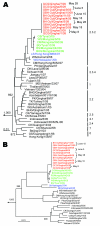New avian influenza virus (H5N1) in wild birds, Qinghai, China
- PMID: 21291602
- PMCID: PMC3204760
- DOI: 10.3201/eid1702.100732
New avian influenza virus (H5N1) in wild birds, Qinghai, China
Abstract
Highly pathogenic avian influenza virus (H5N1) (QH09) was isolated from dead wild birds (3 species) in Qinghai, China, during May-June 2009. Phylogenetic and antigenic analyses showed that QH09 was clearly distinguishable from classical clade 2.2 viruses and belonged to clade 2.3.2.
Figures


References
Publication types
MeSH terms
LinkOut - more resources
Full Text Sources
Medical
